Buddha Jayanti : The Buddhist Order
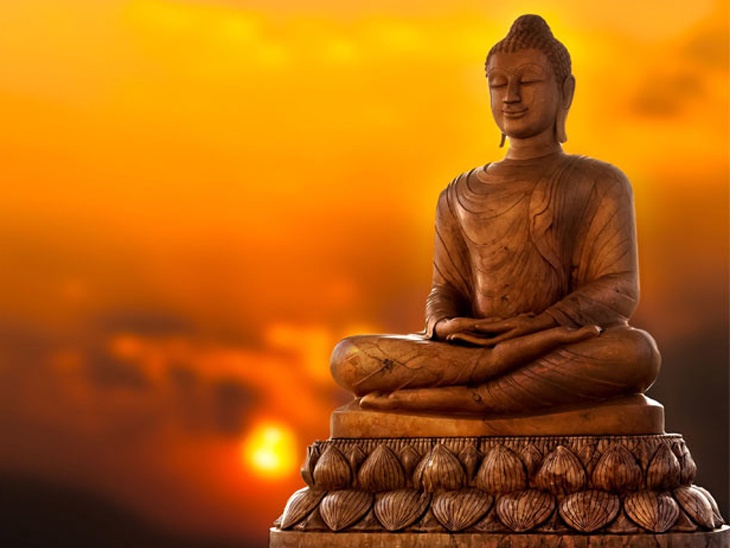
During those days, there was a very rich merchant at Varanasi. He had a young son named Yash. Yash was afforded all kinds of luxuries and comforts in his life. One night, Yash’ was awakened suddenly and saw his lady attendants sleeping in his pleasure palace. These attendants, who seemed beautiful in the day, disgusted him at this time. They were sleeping like the dead bodies. Some seemed to open half eyes while some opened their mouths. Some were bending their heads while others were vomitting. This scenerio saddened him and he wished to abandon his palace for the sake of deliverance. At night, he departed towards the Deer Park at Rishipatan leaving aside the pleasures of palace.
At this time, the Blessed One was on a walk (Chankraman). As he saw Yash coming, he stopped walking and sat down at a place. While walking, Yash was uttering: “Lo, the world is full of pain and sorrow. Where to escape from this hateful and dirty world.”
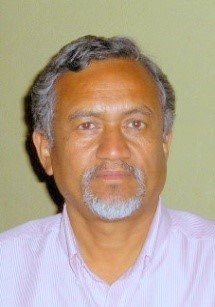
Hearing these words of Yash, the Blessed One made utterences: “Oh Yash, here you can get yourself ridden of sorrow and pains. Here you can attain peace and supreme knowledge. Come here, oh good son. Listen to the knowledge which will relieve you from the sorrows of this world.
Yash took off his golden shoes therein, went to the Lord (Buddha), prostrated before him and sat himself in a corner.
Then the Blessed One narrated to him the characteristics of charity, moral precepts, heaven, lust, delusion, renunciation etc. serially and the fruits to be reaped by pursuing these activities. After narrating the features of different human activities like these, the Blessed One then gave a lessen on Four Noble Truths and Noble Eightfold Paths. These lessons made Yash to attain the first stage of Buddhahood or enlightenment known as Srotapanna,
As the father of Yash came to know about the flight of Yash from Varanasi, they sent horsemen to all directions in search of his son. He too went towards the Deer Park at Rishipatan.
Seeing the footprints of Yash’s shoes, he pursued the footprints in search of his son. As he was about to reach to his son, the Buddha wished to save Yash from the vision of his father. So he covered up Yash with his yogic power.
As the merchant (father of Yash) reached before the Buddha, he asked Him: “O Lord, have you seen my son Yash?” The Buddha replied: “Sit for a while, you will find your son Yash in this very place after a few moment.”
The merchant was consoled by these words. He prostrated before the Blessed One and took a seat beside Him. Then the lord gave lessons to him also in regard to the characteristics of different activities serially. Yash’s father also got clear vision as regards the dhamma. Then, he requested to the Exalted One with the words: “0 Blessed One, thy teachings have helped me to realize the real dhamma as a light helps to see many things in the darknes or as someone finds the real path by the guidance of others. From today onwards, I take refuge unto thee and unto the law (dhamma) and the sangha (order of monks).”
And this merchant was the first lay disciple to take refuge in the triple gems.
The discourses given by the lord made Yash also to realize the dhamma making him free from grasping and attachment. As the Buddha understood that Yash has been free from grasping and attachment, he removed his yogic power so that he may be revealed to his father. Within a few moment, the merchant saw his son seated beside him. Then he asked to his son: “Yash, what happened to you. Your mother has sunk into a pit of sorrow because of your absence. She will leave her life bewailing in your remembrance. Help me protect the life of your mother.”
Hearing these words, Yash Kumar turned his face towards the lord. The lord understood the feeling of Yash and hence he told to the merchant: “Oh merchant, Yash has realized the dhamma well. He had destroyed all the aspirations and attachments. Is it possible that Yash will return home to enjoy the low means like household life or sensual pleasure?”
The merchant replied “No, it is not possible. Yash will no more enjoy the impermanent happiness of a family life. Yash has been blessed. I pray you to accept the offering of food at my house accompanied also by Yash.” The lord accepted the invitation with silence.
As and when the merchant had returned, Yash solicited the Buddha to accept him as his disciple and prayed for ordination in the order. The Buddha also accepted his discipleship and ordained him in his order.
Invited by Yash’s father, the Buddha reached to the merchant’s house escorted by Yash. When the Buddha had taken a seat, the mother and wife of Yash appeared before the lord, saluted him by bowing head and sat in a corner.
The Buddha then gave a discourse on dhamma to them too. As he found both these women delighted, he gave a discourse on Four Noble Truths and Noble Eightfold Paths. These womenfolk attained clear insight in regard to the true dhamma. They also achieved clear religious eyes. Startled with such attainment, both of them asked the Buddha to give them refuge in triple gems. These two womenfolk were the first lay disciples to take refuge in the triple gems.
After being initiated into triple gems, they offered delicious food to the Buddha and Yash. The Buddha, after eating the food, gave discourse on dhamma and thus made them pleased. Thereafter, he returned to the Deer Park at Rishipatan.
Yash had four intimate friends named Bimal, Subahu, Purnajit and Gabampati. As these friends came to know that Yash has renounced the family life and become a monk, they came to meet him. Yash took them to the Buddha and asked Him to deliver them by his religious teachings. The Buddha gave instructions to them on the true dhamma.
After hearing the instructions, the four friends too attained clear vision on the dhamma (law). They asked the. Buddha for discipleship and ordination which the Buddha complied with. These four friends of Yash too became free from attachment and, grasping, and attained the stage of Arhat or a life free from rebirth. From this time onwards, there emerged fourteen arhats (enlightened beings) in the world.
The other fifty friends of Yash also carne to know of his ordination into the Buddha’s order. This made them to reflect that the dhamma in which Yash had been initiated, by abandoning the pleasure of a well to do life, must in fact be an excellent dhamma. Hence they went to meet their friend Yash and encircled him.
Yash took them to the Buddha aQd asked Him to instruct them on dhamma. The Buddha also gave them instructions which made all the friends of Yash to attain clear vision on the dhamma (law) and became enlightened (arhat) ones.
At this time, there were altogether sixty one enlightened (arhat) monks in the world.
As the rainy season had elapsed, one day the Buddha told to his disciples. “0 monks, I have been freed from all the bondages that may be available in the world. Similarly you too have been freed from all these entanglements. Now I ask you to go to the world and preach the law as taught by me. You do this for the welfare and happiness of the living beings, i.e., men and gods, and for generating kindness among them. Preach this law to them which brings welfare in the beginning, in the middle and in the end. There are people who have not been able to find the path for delivering themselves. Go and teach them the true law so that they may find the path and improve their actions.”
Sending his disciples to spread the law at different directions in this way, the Holy One also departed towards Senani Village at Uruwel for preaching the true law.
On the way to Uruwel, the Buddha was passing through a vast forest. In the forest, He sat under a tree and rested for a while. At this time, thirty princes, accompanied by their wives, were strolling in the forest. Among them, one prince did not have his own wife. So he had brought a whore along with him. The Whore escaped from there carrying, with her, all the ornaments and dresses of the princes. The princes at this time, were engaged in amusements. The princes began to seek the whore hither and thither in the forest. Seeing the Shakya saint sitting Under a tree, the princes went to him and asked whether he had seen a woman coming towards that direction. The Buddha asked the princes whether it would be better for them to search a woman or to search their own selves. When the princes desired to seek their own selves, the Buddha gave them religious instructions. This made the princes to attain clear vision on the dhamma. They also asked refuge in the Buddha and his order. The Buddha ordained them into his order and helped them to end their sufferings.
After this ordination, the Buddha send these princes to different villages for preaching his law and he, too, departed towards Uruwel.
The Buddha arrived at Uruwel and met three Brahman ascetics– Uruwel Kasyap, Nadi Kashyap and Gaya Kashyap. The ascetics, who pursued fire worshipping, were the well known preceptors having five hundred, three hundred and two hundreed disciples respectively. The lord prevailed upon them by displaying thousands of supernormal powers and received all of them into his order. And when they were seated on the Gaya Scarp, he preached them the third sermon known as the ‘Discourse on Fire’ with the words:
“Oh monks, all things are on fire. The eye is on fire, fonts are on fire, eye-consciousness is on fire. Similarly the impressions received by the eye are also on fire. The feeling–pleasant, unpleasant or neutral– originating in the impressions received by the eye is likewise on fire. And the fire is the fire of greed, hatred and delusion. With birth, old age, death, lamentation, misery and despair, they are afire.”
“And so is the case with the ear, nose, tongue and touch. Similarly the mind, thoughts, mind-consciousness and the impressions received by mind and the sensations that arise from the impressions also are on fire.”
” Knowing these facts, the true disciples conceive disgust for all these things. In this way they are divested of desire and thereby freed of it too. They know that becoming has been extinguished, that they have lived pure lives, that they have done what it behoved them to do, and that they Obt off mortality for ever.”
In the course of this Sermon on Fire, the minds of all the mendicants assembled there were freed from attachment and stains. And they attained the stage of enlightenment (arhat) too.
Attended by these thousand arhats (enlightened ones), among whom the prominent was Uruvel Kashyap, the Buddha repaired to the Palm Grove nearer to Rajgriha. He was there in fulfilment of the words which he had given to King Bimbisar. The news of the Exalted One’s arrival was reported to King Bimbisar.
King Bimbisar hastened to the Palm Grove accompanied by hosts of retinue. He payed tribute to the Buddha by bowing his head and sat down at a corner. The retinue also sat down likewise.
King Bimbisar found himself difficult to understand whether the Buddha had become the disciple of Uruvel Kashyap or Uruvel Kashyap of the Buddha. In order to resolve this doubt, the Buddha asked Uruvel Kashyap about the cause of giving up of fire worshipping. In response to the Buddha’s question, Uruvel Kashyap replied that he had given up fire worshipping because this path did not lead him to birthless and deathless state except hankering after the luxuries of the world. After this response, Uruvel Kashyap bowed down to the feet of the Exalted One with the words: “The Blessed One is my master and I am his disciple.” These words of Kashyap helped to resolve the doubt arising in the minds of King Bimbisar and all the retinue.
Thereafter, the Buddha gave’ a series of discourses on the dhamma and on the Four Noble Truths. These discourses made King Bimbisar, with all his retinue, to understand the true law and they entered into the first stage of sainthood– Srotapanna. Those who did not enter into this stage also became the lay disciples of the Buddha.
Before returning to the palace, King Bimbisar invited the Buddha and his disciples to a feast at the palace on next day. The Buddha accepted the invitation with silence.
Next day, the Buddha repaired to the Royal Palace accompanied by thousands of his disciples. They were served a very delicious meal by King Bimbisar. At this time, a thought emerged in the heart of King Bimbisar that the Buddha and his disciples did not have a proper place to stay at. He wanted that he should offer to the order of the Buddha an excellent place for settlement. He also thought that the place, which he would offer, should be neither so much far nor so much near from the main city. In this connection, he found his bamboo grove as the best area for offering.
With these thoughts in mind, the emperor presented himself before the Exalted One and offered the Bamboo grove to the Buddhist order. He confirmed this endowment by the pouring out water from a holy jar (Kalas). The Blessed One too accepted it heartily. And this was the first endowment offered in the name of the Buddhist order.
During those days, there was an ascetic in Rajgriha named Sanjaya. Among his twenty-five thousand disciples, two Brahman ascetics named Upatissa and Kolit were the prominent ones. Both of them were from the families of excessively rich merchants.
Roopsari was the name of Upatissa’s wife while Maudgali the name of Kolit’s wife. Both these Brahman wives produced one son each on the same day. As the children were born in the village of Upatissa and Kolit, they were named respectively as Upatissa and Kolit.
After being initiated into ascetic life, both these Brahman sons were named respectively as Sariputra (son of Sari) and Maudgalyan (son of Maudgali) and became famous as the prominet disciples of the Buddha later on.
Upatissa and Kolit were very close friends. After they had grown young, both of them abandoned home and became the disciples of Sage (ascetic) Sanjaya. One day, they promised among themselves that anyone among them, who first attains salvation, will have to convey this message to another one too.
One day, Kolit met venerable Assaji, the youngest among the first five disciples of the Buddha, walking at Rajgriha with his begging bowl. Upatissa was attracted to find in him a majestic personality and, hence, followed him. He met venerable Assaji in the way while he was taking food under a tree. He reached there and asked:
“Reverend sir, you seem to be very much overjoyed. What made you to practise asceticism? Who is your preceptor? What kind of path do you follow?”
Venerable Assaji replied: “Oh ascetic, there is an all enlightened saint from the lineage of the Shakyas. He is my preceptor. I follow the path taught by him.”
Upatissa asked again: “What kind of path does he teach?” In response to this query, Assaji recited the entire philosophy of the Buddha into one stanza and stanza ran as:
ये धम्मा हेतु पभावा, तेसां हेतु तथागतो आह
तेसां च यो निरोधो, एवं वादी महा समणोति ।
Whatsoever things are produced from causes, the Buddha has revealed th0 causes of all these. Similarly this great saint has proclaimed, how they cease to be produced.



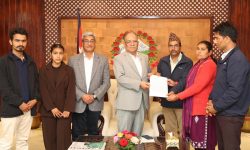
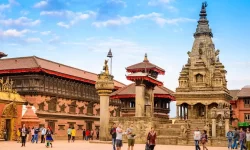



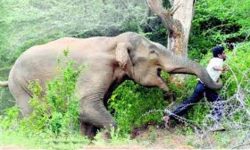
 सगरमाथा आरोहण उत्साहजनक : उठ्यो ५० करोडभन्दा बढी राजस्व
सगरमाथा आरोहण उत्साहजनक : उठ्यो ५० करोडभन्दा बढी राजस्व राष्ट्रिय महिला टीमका ६ क्रिकेटरले मलेसियामा सुपर कप खेल्ने
राष्ट्रिय महिला टीमका ६ क्रिकेटरले मलेसियामा सुपर कप खेल्ने नीति र नेतृत्वमा एमालेभित्र विवाद छैन : अध्यक्ष ओली
नीति र नेतृत्वमा एमालेभित्र विवाद छैन : अध्यक्ष ओली वीरगञ्ज भन्सारद्वारा आठमहिनामा १ खर्ब १४ अर्ब राजस्व सङ्कलन
वीरगञ्ज भन्सारद्वारा आठमहिनामा १ खर्ब १४ अर्ब राजस्व सङ्कलन एमालेको महाधिवेशन प्रतिनिधि परिषद् बैठक सुरु
एमालेको महाधिवेशन प्रतिनिधि परिषद् बैठक सुरु युएईमा आएको बाढीमा परी एक नेपालीको मृत्यु
युएईमा आएको बाढीमा परी एक नेपालीको मृत्यु युएईसँग हारेसँगै नेपालकाे एसिया कप खेल्ने सम्भावना समाप्त
युएईसँग हारेसँगै नेपालकाे एसिया कप खेल्ने सम्भावना समाप्त जापानमा गयो शक्तिशाली भूकम्प
जापानमा गयो शक्तिशाली भूकम्प सुनको मूल्य घट्यो, कतिमा हुँदै छ किनबेच ?
सुनको मूल्य घट्यो, कतिमा हुँदै छ किनबेच ? मुम्बई इन्डियन्सका कप्तान हार्दिक पाण्ड्यालाई १२ लाख जरीवाना
मुम्बई इन्डियन्सका कप्तान हार्दिक पाण्ड्यालाई १२ लाख जरीवाना
प्रतिक्रिया